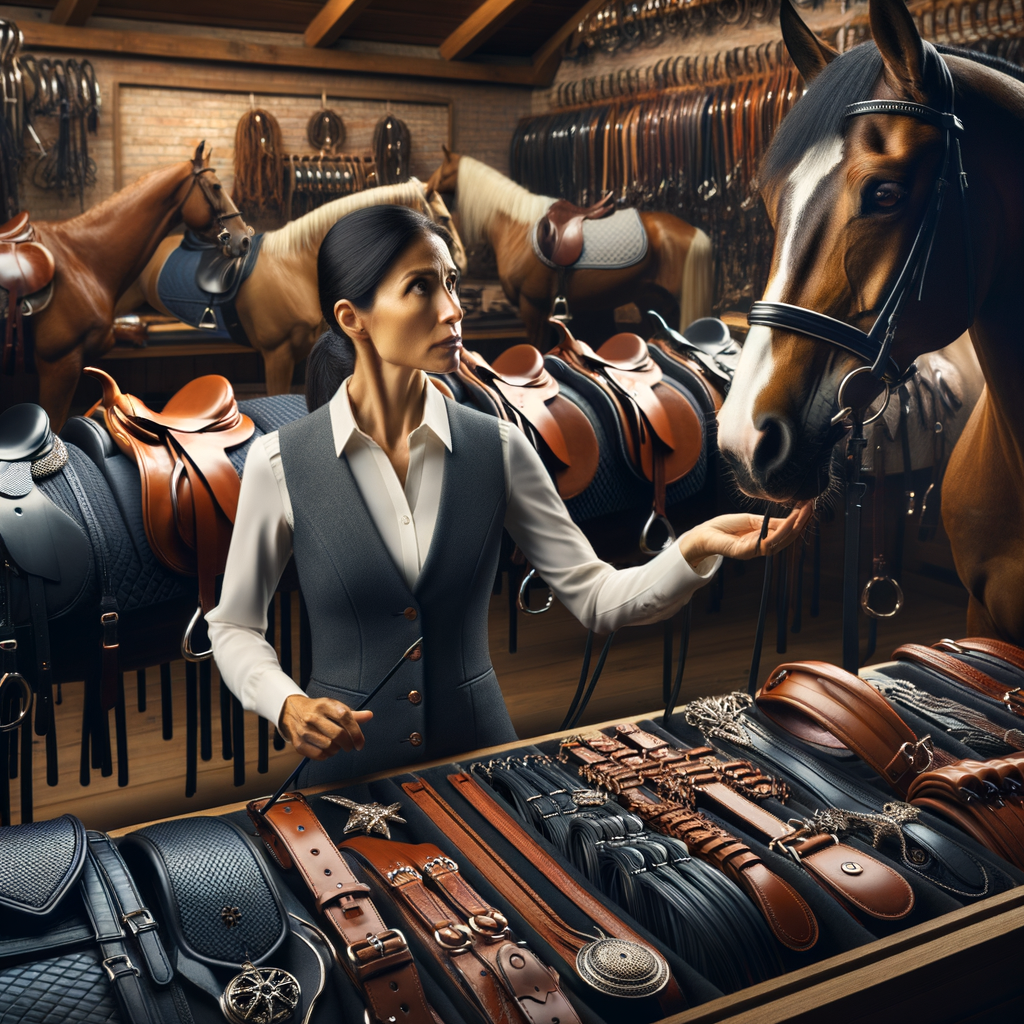
Introduction to Quarter Horse Tack Selection
Welcome to our comprehensive guide on Quarter Horse tack selection. This guide is designed to help you understand the importance of choosing the right tack for your Quarter Horse and provide an overview of different Quarter Horse activities. Let’s get started!
- Understanding the importance of choosing the right tack for Quarter Horse
Choosing the right tack for your Quarter Horse is crucial. The tack you select can significantly impact your horse’s comfort, performance, and safety. For instance, a saddle that doesn’t fit properly can cause discomfort and even injury to your horse. On the other hand, a well-fitting saddle can enhance your horse’s movement and allow it to perform at its best.
Moreover, the right tack can also affect your riding experience. A well-fitted bridle, for example, can provide better control and communication between you and your horse, leading to a more enjoyable and safer ride.
Therefore, it’s essential to invest time and effort in selecting the right tack for your Quarter Horse. Remember, the key is to choose equipment that fits well and suits your horse’s needs and the activities you plan to engage in.
- Overview of different Quarter Horse activities
Quarter Horses are versatile and can participate in a wide range of activities. Here are some popular Quarter Horse activities:
| Activity | Description |
|---|---|
| Racing | Quarter Horses are known for their speed, especially over short distances. They often participate in sprint races. |
| Show Jumping | With their powerful hindquarters, Quarter Horses excel in show jumping events where they are required to jump over obstacles. |
| Trail Riding | Thanks to their calm and steady nature, Quarter Horses are excellent for trail riding, whether for leisure or competitive events. |
| Rodeo Events | Quarter Horses are often seen in various rodeo events, including barrel racing, calf roping, and team roping. |
Each of these activities requires specific tack. For instance, racing might require a lightweight saddle for speed, while trail riding might need a more comfortable saddle for long rides. Therefore, understanding your horse’s activities can help you make better tack selection decisions.
Understanding Quarter Horse Activities
Quarter Horses are versatile and athletic, making them suitable for a variety of activities. Let’s delve into some of the most common activities that Quarter Horses excel in.
Common Quarter Horse Activities
- Racing
- Trail Riding
- Show Jumping
- Dressage
Quarter Horses are renowned for their speed over short distances. They are named “Quarter” horses because they can outpace other breeds in races of a quarter mile or less. In fact, they have been clocked at speeds up to 55 mph!
With their calm and steady nature, Quarter Horses are excellent for trail riding. They can navigate different terrains with ease, making them a popular choice for leisurely rides through the countryside.
Although not as commonly associated with show jumping as some other breeds, Quarter Horses have the agility and power to excel in this discipline. Their quick reflexes and compact build make them capable jumpers.
Dressage is a test of a horse’s obedience, flexibility, and balance. While Quarter Horses are more commonly associated with western riding disciplines, their intelligence and willingness to please make them suitable for dressage as well.
In conclusion, the Quarter Horse is a versatile breed that can participate in a variety of activities. Whether you’re interested in high-speed racing, peaceful trail rides, the precision of dressage, or the excitement of show jumping, there’s a Quarter Horse activity that’s perfect for you.
Choosing the Right Tack for Horse Activities
When it comes to horse activities, selecting the right tack is crucial. The tack you choose can significantly affect your horse’s comfort and performance. Here, we will discuss the factors to consider when selecting tack and how the type of activity influences tack selection.
- Factors to Consider When Selecting Tack
- Fit: The tack should fit your horse properly. Ill-fitting tack can cause discomfort and even injuries.
- Quality: High-quality tack can last longer and provide better comfort and safety.
- Horse’s Preference: Some horses may prefer certain types of tack over others. Pay attention to your horse’s reactions when trying different tacks.
- Rider’s Comfort: The tack should also be comfortable for the rider. Uncomfortable tack can affect the rider’s ability to control the horse effectively.
- How Activity Type Influences Tack Selection
- Racing: Racing tacks are designed to be lightweight to not slow the horse down. They also provide the necessary control for high-speed activities.
- Trail Riding: Trail riding tacks are designed for comfort over long distances. They often have extra padding and are made of durable materials to withstand the elements.
- Show Jumping: Show jumping tacks need to provide excellent control and stability. They often have a close-contact design to allow the rider to communicate effectively with the horse.
- Dressage: Dressage tacks are designed for precision and elegance. They often feature a deep seat to help the rider maintain a correct and balanced position.
Choosing the right tack for your horse is not just about aesthetics. It’s about ensuring the comfort and safety of your horse. Here are some factors to consider:
The type of activity you plan to do with your horse greatly influences the kind of tack you should choose. Different activities require different types of equipment. Here are some examples:
In conclusion, choosing the right tack for your horse activities requires careful consideration of various factors. Always remember, the comfort and safety of both the horse and rider should be the top priority.
Horse Riding Equipment Selection
When it comes to horse riding, the right equipment can make all the difference. Not only does it ensure your safety, but it also enhances the comfort and performance of your horse. Let’s explore some of the essential horse riding equipment you should consider.
Essential Horse Riding Equipment
Here are the four key pieces of equipment every horse rider needs:
- Saddle: This is where you sit when you ride. A good saddle is crucial for both rider comfort and horse health. It should fit the horse’s back perfectly and provide the rider with a secure and comfortable seat. Saddles come in different types, including English, Western, and Australian, each designed for specific riding styles and activities.
- Bridle: The bridle is a piece of equipment used to direct a horse. It includes a headstall that holds a bit that goes in the mouth of the horse, and the reins that are used by the rider to give directions. Bridles come in various styles, including snaffle, double, and western bridles.
- Stirrups: Stirrups are where you place your feet when riding. They help you maintain balance and control while riding. They come in different styles and sizes, and it’s important to choose one that fits your foot size and riding style.
- Horse Boots: These are worn by horses to protect their hooves and legs. They come in different styles, including bell boots, splint boots, and brushing boots, each designed to protect a specific part of the horse’s leg.
Choosing the right equipment is a crucial part of horse riding. It not only ensures your safety but also enhances the comfort and performance of your horse. So, take your time to understand each piece of equipment and choose the one that best fits your needs and riding style.
Selecting Equestrian Equipment for Different Activities
When it comes to horse riding, the type of equipment you choose can greatly impact your performance and safety. Different activities require different types of gear. Let’s delve into the specifics of selecting the right equipment for various equestrian activities.
-
Choosing Equipment for Racing
Racing is a high-speed activity that requires lightweight and aerodynamic equipment. A racing saddle, designed to be lighter and smaller, allows the horse to run faster. A racing bridle, typically made of thin, lightweight leather, is also essential. Don’t forget the safety gear, including a helmet and protective vest for the rider.
-
Selecting Equipment for Trail Riding
Trail riding calls for comfort and durability. A trail saddle is designed with a deep seat and high cantle to provide comfort during long rides. A sturdy bridle and reins are needed to navigate through various terrains. Also, consider horse boots to protect your horse’s hooves from rocky trails.
-
Picking the Right Gear for Show Jumping
Show jumping requires precision and control. A jumping saddle, with its forward-cut flaps, allows for greater leg movement. A bridle with a snaffle bit provides control without discomfort to the horse. Safety equipment, such as a helmet and body protector, is mandatory for the rider.
-
Essential Equipment for Dressage
Dressage focuses on the harmony between horse and rider. A dressage saddle, with its straight-cut flaps, aids in maintaining the correct position. A simple bridle with a snaffle bit is commonly used. Remember, the rider’s attire, including a dressage coat, white breeches, and tall boots, is also part of the equipment in dressage.
In conclusion, the right equipment can enhance your performance and ensure safety in different equestrian activities. Always consider the specific requirements of the activity when selecting your gear.
Quarter Horse Riding Gear
When it comes to riding a Quarter Horse, the right gear is crucial. It not only ensures your safety but also enhances your performance. Let’s delve deeper into the importance of proper riding gear.
Understanding the Importance of Proper Riding Gear
Proper riding gear plays a significant role in horse riding. It’s not just about looking the part; it’s about safety and performance. Let’s explore these two aspects in more detail.
- Role of Riding Gear in Safety
- How the Right Gear Enhances Performance
Riding gear is designed to protect you. A helmet can prevent head injuries, while a good pair of riding boots can protect your feet and ankles. Riding gloves can prevent blisters and offer a better grip on the reins. A safety vest can protect your torso in case of a fall. According to a study by the Equestrian Medical Safety Association, wearing the correct riding gear can reduce the risk of serious injury by up to 50%.
The right gear can also enhance your performance. For example, a well-fitted saddle can improve your balance and stability, making it easier for you to control your horse. Proper riding boots can provide better grip in the stirrups, allowing you to ride more confidently. According to a survey conducted by the American Quarter Horse Association, riders who used the correct gear reported a significant improvement in their performance.
As you can see, investing in the right riding gear is essential for both safety and performance. So, whether you’re a beginner or an experienced rider, make sure you’re equipped with the right gear before you hop on your Quarter Horse.
Choosing the Best Tack for Quarter Horse
When it comes to Quarter Horse riding, selecting the right tack is crucial. The tack you choose can significantly impact your horse’s performance and comfort. Here are some key considerations to keep in mind when choosing the best tack for your Quarter Horse.
- Considerations when choosing a saddle
- Size: The saddle should fit your horse perfectly. An ill-fitting saddle can cause discomfort and even injuries.
- Material: Saddles are made from various materials, including leather and synthetic materials. Choose a material that is durable and easy to clean.
- Type: There are different types of saddles, such as Western and English saddles. Choose a type that suits your riding style and your horse’s activities.
- How to select the right bridle
- Size: Like the saddle, the bridle should also fit your horse perfectly. A too tight or too loose bridle can cause discomfort to your horse.
- Material: Bridles are usually made from leather. Choose a bridle made from high-quality leather for durability and comfort.
- Type: There are different types of bridles, such as snaffle bridles and curb bridles. Choose a type that suits your horse’s needs and your riding style.
- Choosing the right stirrups and horse boots
- Stirrups: Choose stirrups that are the right size for your feet. They should also be made from durable materials to withstand the rigors of horse riding.
- Horse boots: Horse boots protect your horse’s hooves and legs. Choose boots that fit your horse well and are made from durable materials.
The saddle is a critical piece of horse riding equipment. It needs to be comfortable for both the rider and the horse. When choosing a saddle for your Quarter Horse, consider the following:
The bridle is another essential piece of horse riding gear. It helps you control your horse. Here’s what to consider when choosing a bridle:
Stirrups and horse boots are also important pieces of horse riding gear. They provide safety and comfort for both the rider and the horse. Here’s how to choose the right stirrups and horse boots:
In conclusion, choosing the right tack for your Quarter Horse involves careful consideration of various factors. The right tack can enhance your horse’s performance and ensure both your and your horse’s comfort and safety.
Conclusion: Horse Riding Tack Selection
As we wrap up our discussion on Quarter Horse tack selection, it’s important to remember that the right choice of tack can significantly impact the performance and comfort of both the rider and the horse. Let’s recap the key points and takeaways.
- Recap of the importance of choosing the right tack: The right tack is not just about aesthetics or cost, but it’s primarily about the safety and comfort of the horse and rider. A well-fitted saddle can prevent injuries and discomfort, while the correct bridle can provide better control and communication between the horse and rider. It’s crucial to consider the horse’s size, shape, and the type of riding activity when selecting the tack.
- Key takeaways for Quarter Horse tack selection: Quarter Horses, known for their muscular build and versatility in various equestrian activities, require specific tack considerations. Here are the main takeaways:
- Ensure the saddle fits properly to avoid pressure points and discomfort. A Quarter Horse typically requires a saddle with a wider gullet and bars due to its broad back.
- Choose a bridle that allows for effective communication. A snaffle bit is often recommended for Quarter Horses due to its mildness and versatility.
- Don’t overlook the importance of other tack items like girths, stirrups, and halters. They should be of good quality, fit well, and be suitable for the intended activity.
In conclusion, the right tack selection can enhance the riding experience and performance of a Quarter Horse. It’s a combination of understanding the horse’s needs, the rider’s skills, and the specific requirements of the equestrian activity. Remember, a well-equipped horse is a happy and high-performing horse.









